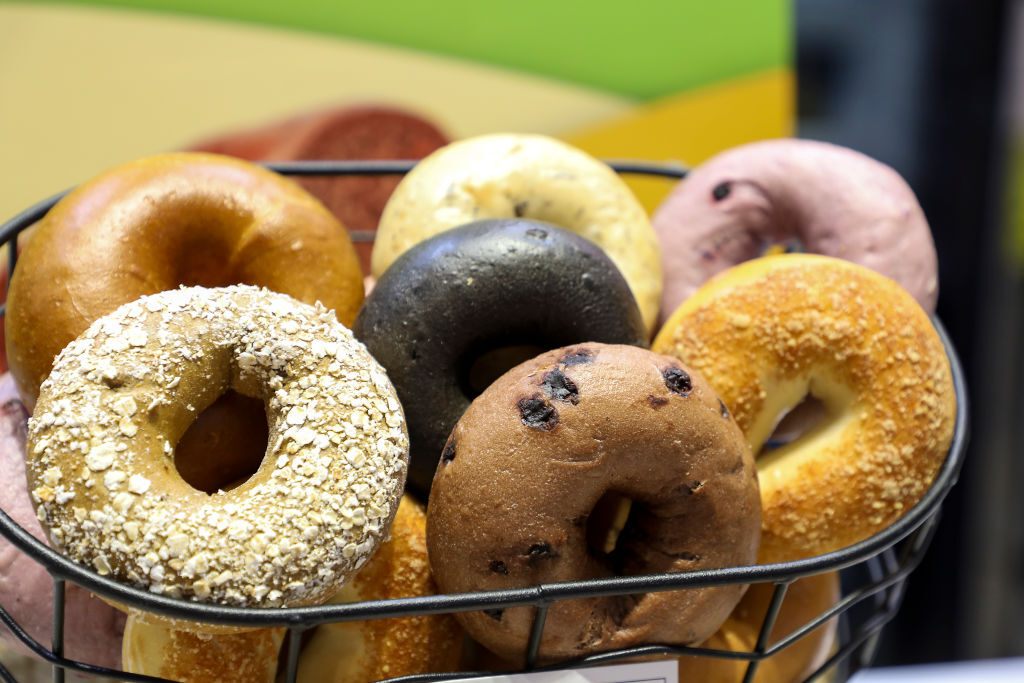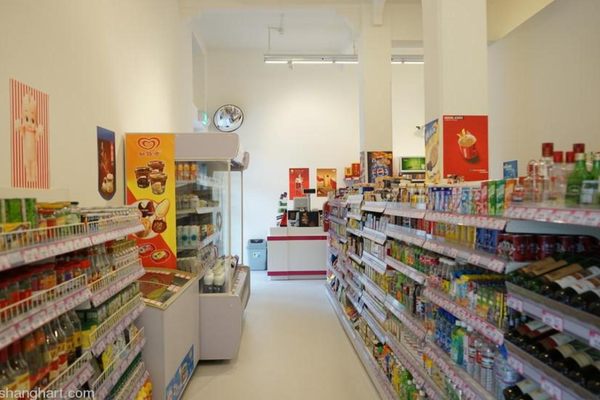These Stuffed, Fluffy Bagels Are Taking China by Storm
Chinese bakers are putting their own spin on a North American classic…minus the poppy seeds.
“There are so many bagel shops right now,” says Shanghai-based food writer and photographer Rachel Gouk. “We only had maybe two bagel shops for the past ten years, and all of a sudden they’re everywhere.”
In 2023, Gouk wrote about her trip to New York Bagelous Museum, a Shanghai bakery she refers to as “not from New York, not a museum, [and] not bagels.” The ring-shaped breads at this and other bagel shops in Shanghai are more like a cross between soft pretzels and Japanese milk bread. Often sold as a pre-made sandwich, with a square of cheese on top, or with a filling baked inside, they’re a far cry from bagels in Western countries.
Sometimes bakers will add colorful dyes to the bagel dough, but it’s the bread’s softness that really distinguishes the Chinese bagel from its Western counterpart. “These sandwiches—they’re pre-made, they’re sitting in a fridge,” says Gouk. “If it was a bagel, it would have died two hours after it was put on the shelf. But it doesn’t, because it’s not a bagel. People are picking them up, and they’re biting through them like it’s no problem.”

China is home to several traditional breads that might be described as bagel-ish. Fujian province in China’s southeast has guāng-bǐng, meaning “Guāng cake,” after the 16th-century general who purportedly invented it as a ration for his soldiers. In western China, the Uighur ethnic minority bakes girde naan, which resembles a bagel except that the hole doesn’t go all the way through. But the bagel you buy in New York and Montreal bakeries, rendered bèiguǒ in Mandarin, has long been regarded in China as little more than a foreign curiosity.
Brooklyn-raised Lejen Shen, owner of the now-closed Mrs. Shanen’s Bagels in Beijing, told The New York Times in 2008 that her Chinese employees were so unfamiliar with bagels that they preferred to consume them chopped up and stir-fried “with cabbage and sometimes bean sprouts.”
In the same interview, Shen spoke of her desire to serve “comfort food for Americans if they are far from home.” Gouk says that there are venues in Shanghai like Spread the Bagel that serve American-style bagels, “you just have to sift through all the not-bagels” to find them.

Only in the last few years post-pandemic have these “not-bagels” (or “Chagels,” as some expats in China call them) become popular. The YouTube channel Chinese Cooking Demystified explains that Western baked goods entered China in three waves. The European colonization of Hong Kong and Macau brought the first wave, resulting in early fusions like pineapple buns and egg tarts in the 19th century. China’s economic reform and opening in the late 20th and early 21st centuries brought a second wave in the form of Taiwanese bakeries, themselves influenced by Japanese baking through the Japanese colonization of Taiwan.
The third and current wave, which skews somewhat closer to Western traditional baked goods, has resulted from an increased number of Chinese returning home after living or studying abroad. Chinese Cooking Demystified notes that people with this experience, while culturally influential, still make up only a small part of China’s population, so “what you’ll usually find is a layering of these three waves.” Bakeries will sell products from all three styles alongside each other, or combine them into a single delicacy.

This is where the Chinese bagel comes in. Though boiled and then baked like a North American bagel, the Chinese bagel lacks its signature dense, chewy texture. Nor is the Chinese bagel quite as fluffy as the Japanese bagel that came before it. Fillings necessitate a different shaping process, setting the Chinese bagel apart even further: Instead of the North American method of rolling a loop of dough against the table to seal its edges, Chinese bakers shape flattened dough around a cylinder of filling and pinch its ends together. And some Westerners find the taste of Chinese bagel dough incongruously sweet.
“When it comes to any Western or foreign food that tries to make it in China,” says Gouk, “there’s always some form of localization.” She points out that many Chinese dislike the texture of hard, crunchy Western breads like the French baguette. “And I think that’s a cultural thing,” says Gouk. “Because all the bread products that you’ll find in China like bao and mantou are very soft.” Many of these are steamed or pan-fried, rather than baked in a Western-style enclosed oven.
Chinese Cooking Demystified describes the bagel as having undergone “bao-ification” in China, with fillings like savory barbecue pork or sweet purple yam borrowed directly from stuffed steamed buns, or bao. Gouk notes that from a business perspective, adding familiar Chinese ingredients to a bagel is a compromise for Chinese bakers, who face the challenge of turning a profit while “having to educate the market” on an unfamiliar product.

“It’s a very young market,” says Gouk. “And in order to survive or even succeed, you have to do your own twist on it.” There’s also an element of necessity in offering these nontraditional flavors, since Chinese bakers can’t sell poppy seed or everything bagels. Poppy seeds are banned in China, since they contain trace quantities of opiates. It’s not enough to get anyone high, but stories abound in North America about people testing positive for drugs after eating bagels topped with poppy seeds.
Ultimately, says Gouk, there’s a market for fusion-style bagels in China “because nobody knows what’s considered authentic versus what is popular.” She compares China’s present bagel wave with the rise of other Western foods that have become widespread in the past decade, like coffee and pizza. Gouk also notes the perception of baked goods as “an affordable luxury” as a factor in their popularity. The perceived foreignness of a bagel sandwich in Shanghai, however different it might be from a bagel sandwich in New York, makes it an exciting novelty that won’t set you back as much as a fancy steak dinner.
Culinary exchange goes both ways. Japanese bagels have begun to spread beyond Asia: In 2023, Japanese-Canadian restaurant group Aburi opened Wa-Bagel in Vancouver, featuring small, fluffy bagels with fillings like cream cheese and red bean paste or eggplant and bacon with miso. But since China’s fusion bagels are a newer phenomenon, it remains to be seen whether a Chinese bagel outpost in North America could be next. For now, at least in Shanghai, says Gouk, “it’s a trend that seems to be sticking.”
Gastro Obscura covers the world’s most wondrous food and drink.
Sign up for our regular newsletter.



























Follow us on Twitter to get the latest on the world's hidden wonders.
Like us on Facebook to get the latest on the world's hidden wonders.
Follow us on Twitter Like us on Facebook